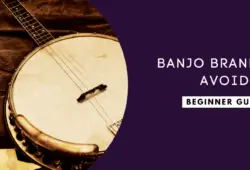The best bluegrass banjo offers the perfect combination of volume, tone, playability, and appearance.
Many people never really know what constitutes a bluegrass banjo, assuming that all 5 string banjos can play bluegrass music.
This is an erroneous misconception because while all bluegrass banjos have a 5 string configuration, not all 5 string banjos are bluegrass banjos.
So, what exactly is a bluegrass banjo?
Table of Contents
Best Bluegrass Banjo To Buy In 2024
1. Deering Sierra 5-String Banjo Review: Best Banjo Overall
The Deering Sierra has a three-ply maple rim that constitutes the pot assembly.
This premium build quality is something you will only find on the world’s best banjos.
The proprietary ‘06 bell bronze tone ring has a stronger hi and low-frequency response for enhanced bass and treble.
At the same time, the mahogany neck and resonator lend some warmth and sweetness to the banjo’s tone, producing the best sound.
Furthermore, the adjustable tailpiece on this professional-grade banjo will allow you to get a sharper sound which is always needed when playing bluegrass.
- Beautiful tone.
- Impeccable quality and craftsmanship.
- Comes with a nice hardshell case.
- None.
2. Gold Tone CC-100R Cripple Creek Banjo Review: Best Value for Money
It’s not often that you find an impressive full-feature bluegrass banjo at a relatively affordable price, yet that’s exactly what the CC-100R offers.
It would be the best choice for newbie banjo players who prefer new banjos to used instruments.
The rolled brass tone ring and resonator give this banjo a beautiful tone, while the low string action makes it pretty easy to play.
Better yet, this banjo is convertible in that you can easily remove the resonator, turning it into an open back banjo.
Open-back playing will be ideal if you wish to make the banjo a bit quieter, like when you are practicing late at night, for instance.
- Modest price point.
- Convertible open back design.
- Solid, durable construction.
- Does not come with a case or gig bag.
3. Pyle PBJ60 Banjo Review: Best Beginner Bluegrass Banjo
This banjo features the classic traditional binding design of a 5 string banjo.
It features quality construction from shabili wood, complete with quality parts and a high gloss finish for durability.
Apart from just looking good, this instrument sounds just as good, producing the classic tone of that great bluegrass sound.
The machine head tuners work pretty well to keep the strings in tune, and the fifth string also uses a geared tuner which enhances the instrument’s playability.
This resonator banjo is pretty lightweight., meaning it would be the best banjo for a beginner to start on before they move to a true bluegrass banjo that’s much heavier to handle.
- Sounds great.
- It plays really well.
- Great build quality for the price.
- Requires assembling, which can be a bit challenging.
4. Washburn Americana B10 Banjo Review: Best Banjo for Durability
Washburn has been making banjos since the 1800s, so you can rely on them to deliver an instrument that will last you a lifetime.
The B10 has a mahogany resonator that pumps out incredible volume and tone.
The clean sound projects really well.
This banjo has a sparkling tone that’s bright and punchy, which is just what you want when playing bluegrass music.
The die-cast tuners allow for smooth tuning.
Whereas the rosewood fretboard and smooth-playing neck make it effortless to play bluegrass music on this banjo.
- Outstanding banjo tone.
- It comes with an armrest for playing comfort.
- Excellent value for money.
- Requires assembly.
5. ADM 5-String Banjo Review: Best Full Kit Banjo
This interesting banjo has a classic body design whereby the upper part resembles a guitar, whereas the lower part resembles a tambourine.
This ADM banjo has a mahogany resonator for that high-quality sound you would want from a bluegrass banjo.
At the same time, however, you can detach the resonator, turning this into an open back banjo ideal for strumming patterns like clawhammer.
The 24 brackets allow for greater control, while the Remo drum head produces a sweet brighter tone that’s very clean and clear for optimum projection in any setting.
This entry-level banjo comes fully assembled right out of the box. All you need to do is tune it, and you are good to go.
Furthermore, the banjo comes with many accessories, including a gig bag, extra strings, picks, a banjo strap, a digital E-tuner, and a hanger.
- Comes with plenty of accessories.
- Convertible resonator design.
- Excellent build quality.
- Tuning it can be a bit challenging.
6. Deering Eagle II Banjo Review
This premium banjo comes with a 3 ply maple rim and a maple neck, similar to what you find on the Deering Goodtime banjo.
Also, it comes with a patented Twenty-Ten tone ring that is made of brass.
This tone ring is the reason why this banjo has a very rich mid-range and excellent bass and treble response.
One of the most striking features of the Eagle II banjo is that it suits both clawhammer and bluegrass styles of music.
As such, it would be best for someone who is just starting on the banjo and hasn’t yet figured out their preferred playing style.
- Rich tone.
- Easy to play.
- Has a lifetime warranty.
- Does not have the traditional bluegrass sound.
7. Gold Tone OB-150 Banjo Review: Best Playability
The planetary tuners, the zero glide fret, and the terminator tailpiece make it very easy to tune this banjo, and it stays in tune incredibly well.
Playability is enhanced as well, such that your fingers don’t have to work hard to get a good tone from the instrument.
You will only find planetary tuners on the best bluegrass banjos, so you know that this is a premium quality banjo.
These tuners hold their tuning much better than guitar style tuners, and they also tune faster.
The sand-cast brass tone ring gives an excellent loud tone.
- Superb playability.
- Authentic banjo tone.
- Has a transferable lifetime warranty.
- The satin finish could use some improvements.
What To Consider When Buying A Bluegrass Banjo
No. Of Strings
All bluegrass banjos have 5 strings. However, not every 5 string banjo in the market is a bluegrass banjo.
It sounds like a bit of a contradiction, but do not worry. I shall explain this further in the subsequent sections.
Any bluegrass banjo will have 5 strings, whereby the fifth string is the drone string that’s located next to the lowest string on the banjo.
The fifth string is imperative to the characteristic bluegrass sound because it tends to keep sounding even when the rest of the strings are being dampened due to chord changes. This creates a ringing drone-like effect that marks out the folk origins of bluegrass music.
Tuning
Typically, most 5 string banjos are tuned to D-B-G-D, going from the highest to the lowest string.
However, unlike other instruments, the strings on a banjo don’t go from lowest to highest across the fretboard. Rather, the fourth string is the lowest, followed by the third, second, and first, and then we have the fifth string being the highest.
The shorter fifth string is always tuned to a high G which is also called the open-G tuning. Bluegrass banjos employ open-G tuning as the standard because it makes it easier to play certain folk songs.
Body
The body of a banjo is also called the ‘rim’ or the ‘pot.’
The best bluegrass banjo will have a wooden pot consisting of multiple plys or layers of hardwood like maple, for instance. You should aim to get a banjo that has at least 3 plys or more.
Tone Ring
The tone ring is usually a separate, solid piece of metal that’s pushed up against the head of the banjo. A true tone ring should sit between the head and the pot, and when correctly fitted, this component truly expands the banjo’s tone character.
This ring is typically made of brass, and it is meant to keep the wooden pot from absorbing and deadening the vibrations from the banjo’s head. The tone ring increases the brightness and bass response in a banjo’s tone, allowing for a bigger, richer and fuller sound.
If the banjo has a great tone ring you may even notice that the instrument provides a clearer tone that projects further, therefore, making the banjo louder. This allows the bluegrass banjo to compete with other louder instruments.
Resonator
A resonator is a round wooden box fastened to the back of the banjo and this box is usually slightly larger than the diameter of the banjo.
It might seem like a quirky feature but actually, the resonator’s work is to project the banjo’s sound forward, thereby giving it more volume and punch particularly in ensemble settings.
The idea is that the sound coming from the back of the banjo head can’t penetrate the resonator. Instead, it will reflect up around the pot and get focused forward to the front of the player.
Without a resonator, the sound coming from the back of the banjo head would get lost in the player’s belly instead of going out into the room.
The dilemma, however, is that the resonator also has a disadvantage whereby the rim of the banjo is now enclosed in a “sound chamber” thereby changing the sound of the instrument.
A deep resonator will produce a slightly darker sound that’s noticeably more hollow. On the other hand, a shallow resonator produces a less hollow sound, with a quicker, more immediate response.
Resonator Flange
This is the ring that’s attached to the pot, designed to hold the resonator in place.
The resonator flange on a great bluegrass banjo will be a solid piece of metal that’s cast then machined, and it will be a one-piece component.
Preferably, the solid cast resonator flange should be made from a soft, un-musical metal to not compete with the tone ring. The ideal flange is toneless and silent but adds volume and sustain.
A lot of people confuse the tone ring for the resonator flange. Here’s the key difference between the two: a tone ring sits between the rim and the pot, whereas the resonator flange is attached to the pot.
Volume & Sustain
The best bluegrass banjos tend to weigh quite a bit because all these accommodations add real weight to the instrument. So these popular banjos are not only louder than their counterparts, but they are heavier as well.
A banjo that weighs more will also sustain its notes longer. The principle is that when given the same energy, a heavier object in motion will stay in motion much longer than a lighter object.
A backless banjo comes without a resonator or a tone ring, and more traditional banjoists who play bluegrass music will go for this style. These banjo players prefer the backless banjo because they feel it provides a more authentic tone for folk music.
Backless banjos are also lighter, so it is a better beginner bluegrass banjo that won’t have the young player straining their back while playing.
An open back banjo has just the resonator and no tone ring. Still, this banjo will play louder and have more sustain than the backless banjo, which has neither a resonator nor a tone ring.
Bluegrass Banjo FAQs
What Is A Bluegrass Banjo?
The bluegrass-style banjo came to be in the early twentieth century, originating in the American south.
This banjo style is credited to Earl Scruggs, who came up with the popular bluegrass style of banjo playing known as the Scruggs style. The Scruggs style is a three-finger picking technique that uses the thumb, index, and middle fingers.
Bluegrass banjo playing avoids strumming altogether, favoring fingerpicking instead. There is a flurry of lightning-fast note changes, which happens so fast that most people don’t even hear the different notes.
How Much Do Bluegrass Banjos Cost?
A high-end professional-grade banjo will always have a tone ring, resonator, resonator flange, and dual coordinator rods. All these features lead to more complex construction, and so this resonator banjo will cost more than an open back or backless 5 string banjo.
That being said, a decent bluegrass banjo with all these deluxe appointments is actually quite expensive and can easily cost upwards of $2,100. Nevertheless, you can still find a moderately-priced bluegrass banjo that’s pretty playable and tonally satisfying.
You can get a beginner banjo that costs about $300, and although it might not give the best tone, it will allow you to learn licks and pick patterns on a cheaper instrument before you commit to a more high-end banjo.
Is Bluegrass Banjo Hard To Learn?
The bluegrass banjo isn’t necessarily hard to learn, but it does have radically different picking patterns from the flat-picked strums used to play the traditional 4-string banjo.
The individual strings on a bluegrass banjo are picked in a complex pattern that can take some time to get used to. Furthermore, these patterns need to be performed at incredible speeds to suit the fast pace of most bluegrass repertoire.
Bluegrass music has a relatively simple structure, so teaching banjo can be easy. However, texturally, this music can be highly complex, with a single piece having plenty of variety and interest as it is passed from one player to another during a performance.
The biggest challenge when playing the bluegrass banjo is getting a comfortable right-hand position that would enable you to play clearly and quickly. Also, being able to play bluegrass comfortably involves finding the right picks since most players opt to wear picks on all three fingers for comfort and increased volume.
Conclusion
The best bluegrass banjos have more ‘ring’ than ‘plunk,’ and this sounding of the open strings is actually a mark of the folk origins of bluegrass music.
You can learn bluegrass picking on any playable 5 string banjo. However, you cannot perform bluegrass without an actual bluegrass banjo with all the necessary accommodations that give it a nice and loud tone.










![How Hard Is It to Play the Banjo? [ANSWERED]](https://musictechhub.com/wp-content/uploads/2020/04/How-Hard-Is-It-to-Play-the-Banjo-250x170.png)

